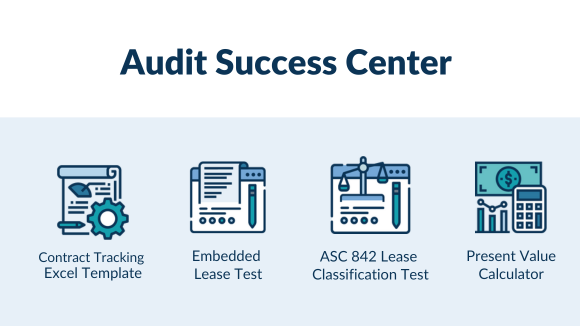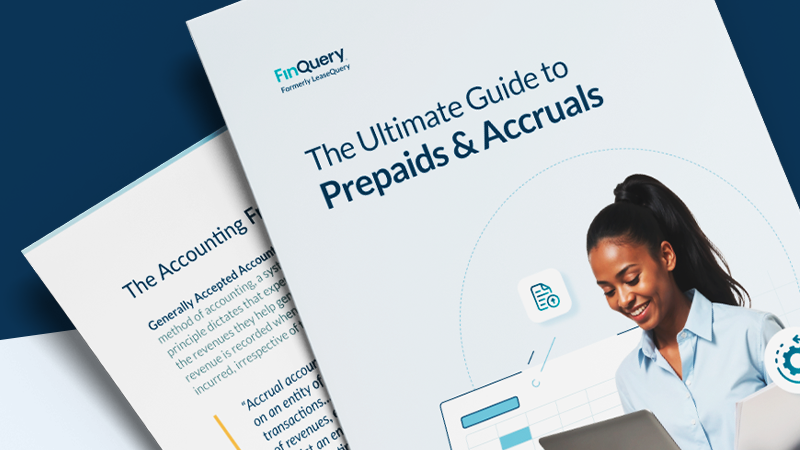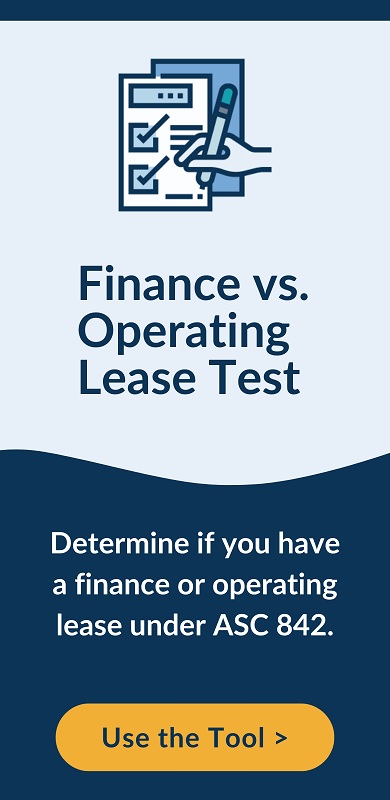1. What is an operating lease?
2. What is a capital lease / finance lease?
3. Capital/finance lease vs. operating lease criteria
- Transfer of title/ownership to the lessee
- Exercising a purchase option
- Lease term
- Present value
- Alternative use
4. Finance lease vs. operating lease accounting treatment
- Do we have to capitalize every lease?
- Are all leases now finance leases?
- If leases are out of scope due to short-term criteria or materiality, are they still required to be disclosed in the footnotes?
6. Summary
Leases are classified into two types under ASC 842, the current FASB lease accounting standard. Lease classification determines how expense and income are recognized as well as which assets and liabilities are recorded. A capital lease, now called a finance lease, is similar to a financed purchase where the lease term covers most of the underlying asset’s useful life. The second classification is an operating lease, which mirrors a rental agreement in that the underlying asset is used for a defined period and typically left with substantial useful life at the end of the agreement.
Lease classification under ASC 842 hinges on five specific criteria. These criteria determine not only the classification of the lease, but also how lessees and lessors should account for a lease. While a distinction between operating and finance lease accounting treatment and presentation still exists, ASC 842 mandates that both types of leases must be on the balance sheet for US GAAP reporting.
What is an operating lease?
According to lease accounting guidelines, a lease is classified as operating if it does not meet any of the five criteria for finance leases which we will discuss below.
In business, operating leases enable lessees to use leased assets similarly to fixed assets during business operations. This arrangement is temporary, however, as these leased assets are eventually returned to the lessor with some remaining useful life. Essentially, the lessee rents the asset to facilitate normal business operations.
What is a finance lease / capital lease?
In lease accounting, a lease is classified as finance if at least one of the five criteria for finance leases (discussed below) are met.
From a business standpoint, finance leases are structured similarly to financed purchases, allowing a company to spread the cost of acquiring an asset over time. The lessee pays for the right to use an asset over the majority of its useful life and the asset is employed in the operations of the lessee’s business.
Lessees who report under US GAAP (ASC 842), follow a two-model approach for the classification of lessee leases as either finance or operating. For lessors, the classification categories for leases are sales-type, direct financing, or operating. ASC 842 allows lessees to classify leases as either finance or operating based on the criteria described below.
Capital/finance lease vs. operating lease criteria
While ASC 840 designated two types of leases, operating and capital, ASC 842 designates leases as operating and finance. One of the changes implemented with ASC 842 was the renaming of capital leases to finance leases. This is mostly a nomenclature change to provide more clarity to the different types of lease commitments, but key differences in how a lease is classified under ASC 840 vs. ASC 842 do exist.
Previously, only four criteria were used to determine if a lease was a capital lease for the lessee. Under ASC 842, there are five criteria to consider for finance leases (ASC 842-10-25-2, page 30):
- Transfer of title/ownership to the lessee
- A purchase option the lessee is reasonably certain to exercise
- Lease term is over a major part of the economic life of the asset
- Present value equals or exceeds substantially all of the fair value of the asset
- Asset is of such specialized nature it offers no alternative use after the lease term ends
If a lease does not meet any of the five criteria, it is an operating lease. Let’s take a closer look at the details of the criteria below.
1. Transfer of title/ownership to the lessee
Criterion: Transfer of ownership occurs by the end of the lease term. This is commonly seen in equipment or vehicle leases where at the conclusion of the lease term, the lessor relinquishes the title to the asset and ownership of the asset transfers to the lessee.
This criterion is the same from ASC 840 to ASC 842. If title transfers to the lessee, the lease is classified as finance.
2. Exercising a purchase option
Criterion: The lease agreement contains a provision where the lessee has the option to purchase the asset, which the lessee is reasonably certain to exercise. This is slightly different from previous guidance where the presence of a bargain purchase option would indicate a capital lease.
A bargain purchase option under ASC 840 was defined as a purchase price significantly lower than the expected fair value of the asset.
To determine whether the option is reasonably certain to be exercised, the lessee should review the following factors:
Contract-based
- Evaluate pricing for purchase option
- Evaluate the duration of the lease term and other options
Asset-based
- Determine the cost of returning the asset to the lessor
- Consider relocation
- Evaluate significant leasehold improvements, etc.
Market-based
- Determine the market price for comparable assets
- Consider laws and regulations
Entity-based
- Determine the significance of the asset to the lessee’s operations
- Define tax consequences
- Evaluate the financial impact of purchasing the asset, etc.
Of course, judgment is required when assessing whether an option is reasonably certain to be elected. For additional guidance, please refer to ASC 842-10-55-26. If this purchase option exists and the lessee is reasonably certain to exercise it, the lease is classified as finance.
3. Lease term
Criterion: The lease term represents the major part of the asset’s economic life. One of the stark differences between ASC 840 and ASC 842 is that companies must now make judgmental assessments that can often vary by class of asset. ASC 840 defined a specific threshold of 75% or more of the asset’s remaining economic life as part of this criterion. The “bright line” or specific threshold for this test was removed under ASC 842.
ASC 842 does not indicate a specific percentage, instead using the terminology “major part,” which requires more judgment. “Major part” is not a defined threshold under ASC 842; however, ASC 842-10-55-2 (page 39) states it is reasonable for an organization to continue to use the 75% threshold to define a “major part” of the remaining economic life of the underlying asset.
In addition, if a lease commences “at or near the end” of the asset’s economic life, the lease term criterion is not used and the lease classification conclusion is based only on analysis of the other four factors. The ASC 842 guidance does not establish a “bright line” for determining when this exception should be used, but suggests scoping out this criterion for leases commencing in the last 25% of an asset’s life is a reasonable approach.
For most situations, if the lease term exceeds 75% of the remaining economic life of an asset and the asset still has at least 25% of its original useful life left, then the lease is considered a finance lease.
4. Present value
Criterion: The present value of lease payments over the lease term, calculated at lease commencement, equals or exceeds substantially all of the fair value of the asset. Similarly, as indicated above for the economic life criterion, ASC 842 removes the bright line of this test. “Substantially all” is also not defined under ASC 842. However, this phrase is used throughout other guidance where a 90% threshold is implied. Furthermore, ASC 842-10-55-2 explains it is reasonable for companies to continue to use the 90% threshold from ASC 840 to define substantially all of the fair value of the underlying asset.
When assessing lease payments under ASC 842, unlike ASC 840, if a portion of property taxes or insurance is considered a lease payment, then it should also be included for the purposes of this classification test. For most situations, if the present value of the lease payments to be made over the lease term exceeds 90% of the fair value of the asset, then the lease is considered a finance lease.
It’s important to determine your organization’s internal policy for each threshold of the classification criteria, document it, and follow it consistently. In our experience, most companies choose to keep the thresholds of 75% and 90%, respectively, from ASC 840 for continuity purposes, as deviating from these standard amounts requires additional work and documentation to substantiate.
5. Alternative use
Criterion: The asset is so specialized in nature it provides no alternative use to the lessor after the lease term. While the first four criteria were present under ASC 840, this fifth criteria is new under ASC 842.
Some real-world examples of leases which may trigger the new specialized use test could be:
- Extensive bodywork (e.g. welding work, etc.) on a piece of equipment specific to the lessee’s business that cannot be easily undone.
- A storage tank leased from a fuel provider that is buried on the lessee’s property. Removing the tank would require excavation.
Though we mentioned a lease must meet a minimum of one of these five criteria to be considered a finance lease, we have often found if a lease triggers the fifth test, it also triggers one of the other four tests. This is because most landlords likely factor in the future use for the asset when establishing the lease payments. As such, the fourth test would be triggered too.
With the example of equipment specifically designed or remodeled to fit the business need of the lessee, these contracts will typically be considered finance leases already because the lessor still needs them to be profitable. The lessor likely structured the contract so the lessee will use the specialized equipment for the majority of its useful life or the lease payments equal substantially all of its fair value.
If the asset is of such specialized nature it offers no alternative use after the lease term ends, then the lease is classified as finance.
Capital/finance lease vs. operating lease accounting treatment
Both finance and operating leases represent cash payments made for the use of an asset. However, because of the distinction between the two types of leases, it is worth mentioning the differences in the mechanics of the accounting for each.
The cash payments made for a lease must have a corresponding expense. This expense represents the lease cost and may differ slightly from the cash payment made each period.
Operating lease accounting
Operating lease payments under ASC 840 were often recorded to rent expense as simply a debit to expense and a credit to cash. Operating lease accounting under ASC 842 is more complex. To summarize, a right-of-use asset and a lease liability must be established at lease commencement (or transition to ASC 842 if the lease started prior), and then reduced over the remaining lease term in addition to recording the cash payment and lease expense.
The total lease expense booked under ASC 842 for operating leases consists of an asset lease expense and a liability lease expense and is equal to the total amount of required cash payments allocated evenly over the lease term. The liability lease expense represents the interest accrued on the lease liability each period and the asset lease expense represents the amortization of the lease asset.
The lease liability is reduced by the periodic cash payment, less any interest accrued on the lease liability balance. The lease asset is reduced by the periodic lease asset expense. Below is an example of an operating lease amortization schedule showing:
- Cash payments
- Liability lease expense
- Liability reduction
- Asset lease expense, and
- Total lease expense under ASC 842:
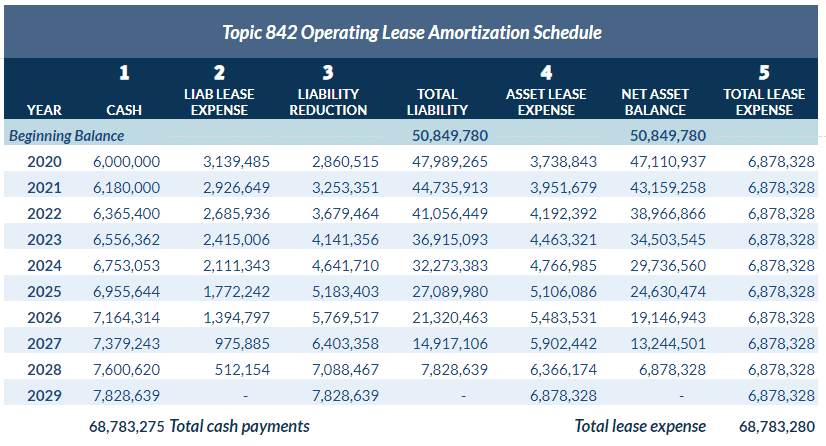
Note: In this example, the variance between total cash payments and total lease expense is due to rounding.
Capital/finance lease accounting
Accounting for finance leases under ASC 842 is essentially the same as capital lease accounting under ASC 840. Similar to operating leases, a right-of-use asset and lease liability must be established at lease commencement (or transition to ASC 842 if the lease started prior), and then reduced over the remaining lease term.
The finance lease liability is treated as capital lease liabilities were previously – the lease payments are split between the interest expense incurred on the lease liability and a lease liability reduction amount. The right-of-use asset is reduced by amortization expense like capital lease assets were reduced by depreciation expense. Below is an example of a finance lease amortization schedule under ASC 842:
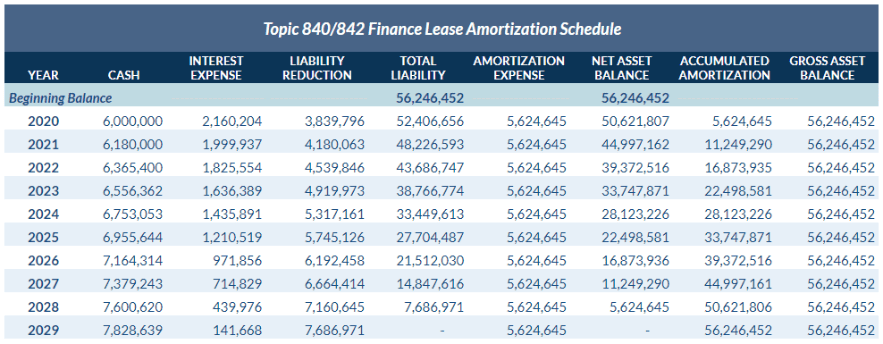
Download our Ultimate Lease Accounting Guide for detailed examples of finance and operating lease accounting
Are you looking for more detail on finance and operating lease accounting under ASC 842? Our Ultimate Lease Accounting Guide includes 44 pages of comprehensive examples, disclosures, and more.
Frequently asked questions
Do we have to capitalize every lease?
All leases are subject to ASC 842. However, some fact patterns can create scope exceptions. The first exception is for short-term leases. Leases with a total term, including renewal options reasonably certain to be exercised, of 12 months or less are exempt from capitalization.
The second exception is for leases which are deemed immaterial to financial statement users. ASC 842 does not establish a materiality exception or threshold, but materiality exemptions are allowed overall by US GAAP. If an entity has a materiality threshold for fixed assets, a similar methodology may be applied to leases as well.
One consideration, however, is that the materiality threshold for leases under ASC 842 must be applied to whole asset groups, not individual leases. For example, if a company determines it has immaterial copier leases, it must aggregate all its copier leases and analyze the total amount of copier leases for materiality to stakeholders. The materiality threshold for leases is a subjective determination which must ultimately be approved by your auditors.
Are all leases now finance leases?
No – the distinction between operating and finance (previously capital) leases remains under ASC 842.
If leases are out of scope due to short-term criteria or materiality, are they still required to be disclosed in the footnotes?
Short-term lease cost, or the cash paid for leases under 12 months in total (which will match the expense), is part of the overall required disclosures for “total lease cost”. Leases which are deemed immaterial have no disclosure requirement.
Summary
Under ASC 842, there is still a distinction between operating and finance lease classification, accounting, and financial statement presentation, despite both being recognized on the balance sheet. The classification of an operating lease versus a finance lease is determined by evaluating whether any of the five finance lease criteria are present. If a lease agreement contains at least one of the five criteria, it should be classified as a finance lease.
Understanding how a lease is classified and its impact to the business will equip your company to successfully maintain compliance under ASC 842.

